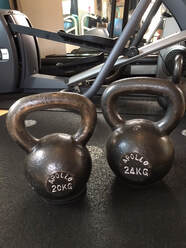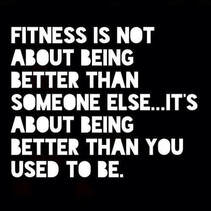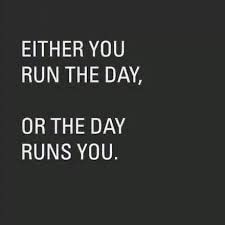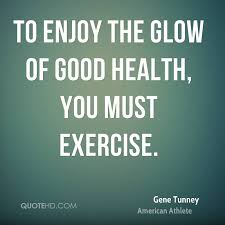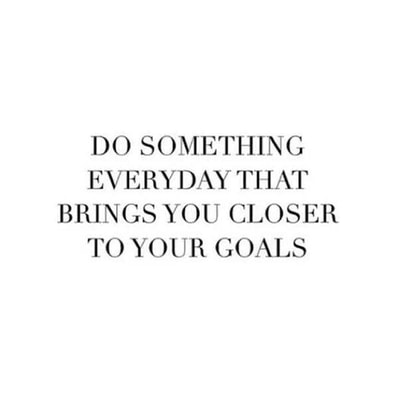|
When the process of exercise feels like a daunting task that overwhelms you and just makes you shut down and not want to do it at all, then you need a plan.
First, think of exercise as something you enjoy, otherwise you won’t do it. Second, find an exercise routine that you can realistically do most days of the week. Mark it as your workout time specifically done to raise your heart rate and work your muscles. Third, write down all your workouts and look them over at the end of each week. This will help keep you motivated and help you stay on track. Some workout examples could be walking, running, high intensity interval training, full body strength training, Pilates mat work, calisthenics, the choices are endless which also makes it very overwhelming, but if you stick to the basics you can’t go wrong. Start with a basic strength training program three times a week which includes these five fundamental moves, a push, pull, squat (or variation of, such as a step up or lunge), hinge, and press. Include an anti-rotation such as a Pallof press. Start by doing each exercise 12 times for three rounds. In addition to strength training add a basic cardio program that raises your heart rate above what it normally is for a specific amount of time. Anywhere between 15 and 45 minutes is good. Any type of cardio that you enjoy will work here such as, but not limited to, brisk walking, elliptical, treadmill, rowing machine, cycling, spin class, or walk/run. The key is to raise your heart rate and breath a little heavy. As you get more comfortable with your exercise routine start to add some stretches or foam rolling at the end of each workout to help keep your muscles happy. When all is said and done however it remains up to you, and only you, to take that first step towards an exercise routine. It won’t happen unless you make it happen. Begin with a plan in your head, write it down, and keep moving forward even if you miss a workout or two, and before you realize it you’ll be deep in a regular exercise routine and feeling stronger and healthier every day! Happy New Year! By M.E. Coffey 12/31/21
0 Comments
I just went with the flow during this workout and couldn’t have felt any better. Starting out with those 150 swings kicked my butt a little, but honestly made the rest of my workout so enjoyable! Hahaa😅
15 kettlebell swings every min for 10 mins (alternating between the 20kg & 24kg) Three rounds⤵️ 2R/2L kettlebell get ups 8R/8L Bulgarian split squats 5R/5L kettlebell front squat to one arm press 15 plank shoulder taps 2 band assist chin ups😉 Foam roll. Good times! ❤️ My interval workout today. 43 minutes of incredible cardio. Heart rate up, heart rate down...
The best part of my run... really, is when I get done, and I stretch, and move on with the rest of my day... and I feel marvelous.😊 No only because I completed another fitness goal, but because all day long I feel the energy of that run. My heart, lungs, and mind are charged up in a very positive way, and I feel simply amazing. A little bit of kick ass cardio goes a long way! Jump on the treadmill and choose a speed that works within your fitness level. I keep the treadmill on a 1% incline, but you could have no incline or more. Whatever is best for you. 3 min warm up 2 min run, 1 min walk x's 5 - 15 mins 1:10 min run, :40 walk x's 8 - 16 mins :15 run :45 sec walk, :30 run :30 walk, :45 run :15 walk x's 6 = 6 mins 3 min cool down And stretch. Don't forget to stretch! 🌵🎄 Here's a quick efficient kettlebell workout for those of us who like to get things done!
20 kettlebell swings 8 goblet squats 5 inchworms :20 :20 :20 side plank, front plank, side plank 5 to 8 rounds Quick fit tip: don't shrug your shoulders as you swing the kettlebell, lats stay engaged. And breathe with the movement. Quick inhale thru the nose as the kettlebell goes down, and forceful exhale thru the mouth as the kettlebell comes up. You’re thinking it’s a cardio blast kind of day, and you’re at the gym, or wherever, and maybe you want to get on that treadmill, but you’re not sure what to do, besides walking that is, since you already know you don’t like running for 30 minutes without stopping, and you are totally not into dull steady state cardio anyway. No excitement there!🤪
And you know you want to get your heart rate up, and feel those endorphins, and burn some calories, and usually you like to have a plan, because sometimes you just can’t wing it, but unfortunately you don’t have a plan right now, so you’re not sure on what to do. But wait! Don’t give up, here‘s a doable, easy peasy plan. But, it’s up to you to adjust the speed to your current fitness level. I say current fitness level because if you stay consistent with your workout routine your current fitness will improve and soon you’ll have a new current fitness level!😉❤️ Easy peasy treadmill workout: 5 minute warm up - 5 mins 1 minute run, 1 min walk x’s 5 - 10 mins :30 run :30 walk x's 10 - 10 mins 1 min run 1 min walk x’s 5 - 10 minutes 5 minute cool down - 5 minutes 40 minutes of heart pumping, lung sucking, endorphin happening, calorie burning fun! Good times! by M.E. Coffey
To improve your overall health and wellness try this simple but effective workout. Do each exercise for 30 to 45 seconds. Rest 15 to 30 seconds between each exercise. 1) Squats - butt back as you sit down, thighs parallel to floor, keep chest forward, push thru heels to stand up and squeeze butt cheeks together tight at the top, yes it matters! 2) Push Ups - on your knees or with hands on a counter, anyway you want, it's all good! Place hands under shoulders or a little wider, bend elbows and bring chest towards floor or counter, exhale as you push back to starting position. 3) Reverse Fly Squeeze - stand tall, arms out in front of body shoulder height, palms up, shoulders away from the ears, keep arms straight with thumbs pointing back, bring arms back and actively squeeze your shoulder blades together. 4) Plank Knee Touch - Plank position on forearms, body is straight than touch knees carefully to floor and back up to straight plank position. 5) 4 point reach and extend - knees and hands on floor, back flat parallel to floor, extend right arm reaching forward as you extend left leg back pushing thru heel, hips stay pointed towards floor, reach and extend, alternate right side and left side. Circuit through one to three times. Aim for three or four times per week to help build functional base strength and body awareness, while burning unhealthy calories and building healthy lean muscle. by M.E. Coffey
When you want to lose weight and start an exercise program it can often seem like a daunting task. But don’t let that overwhelm you, the key is to establish an exercise routine for the majority of your week so it becomes a habit. And, strength training should be part of your routine since it builds up muscle and defines your body in a way that strict cardiovascular exercise can't do. As you establish your routine it helps to write down your workouts and meal choices so you have an honest picture of how you're doing during the week. And if you have a slip up don't worry just get back on track again. Here's a guideline on how to organize your exercise routine: Monday: 30 minutes of cardiovascular exercise Tuesday: 30 to 45 minutes of strength training Wednesday: 45 minutes of cardiovascular exercise Thursday: 30 to 40 minutes of strength training Friday: 30 minutes of cardiovascular exercise Saturday: 30 to 45 minutes of strength training Sunday: rest Adjust the days to what works best for your schedule, but the key is to stick to your routine so it becomes a habit. Like brushing your teeth. Or drinking coffee! Enjoy the process, and recognize the value of your hard work. Dedication and commitment will help you move forward towards a healthier happier you! Be your motivation! by Mary Ellen Coffey
Four things to keep in mind when walking is your cardio workout: One: walk 30 to 45 minutes three days a week to increase your energy and metabolic rate. This helps to reduce excess body fat and releases endorphins, the feel good chemicals in your brain. Two: walk faster 30 seconds to one minute to increase heart and lung health. This helps to reduce the risk of coronary artery disease by lowering high blood pressure and high cholesterol and increases lung capacity. Three: skip a few times during your walk and swing your arms higher. This helps to strengthen the skeletal system which helps to reduce the risk of osteoporosis and helps to increase joint range of motion. Four: walk after eating breakfast, lunch or dinner. This helps with digestion by allowing your food to process better. By Mary Ellen Coffey
What does this mean to you? Do something every day that brings you closer to your goals. I have many goals, I think we all do, goals are not just a one or nothing kind of thing. One of my many goals, especially as I age, is to move well, and stay as strong as I can for as long as I can. One way I do that is through exercise. And I like to be efficient, so I’m all about functional fitness training which keeps me strong to do the things I love to do without running out of gas too soon! So, one of my goals is functional training most days of the week for 30 to 45 minutes. And that’s a reasonable goal I can happily meet. Plus cardio, don’t forget cardio! Are you doing something today to bring you closer to your goals? By Mary Ellen Coffey
Let's face it, exercising is somewhat time consuming, and sometimes a little hard, but when you take on a consistent strength training routine, and you work towards strengthening the muscles required to squat, push, pull, press, hinge, rotate, and move in all directions you're essentially helping your body to move more efficiently. Imagine looking over your shoulder to back up your car, or change lanes, and you pull a muscle in your neck because you weren't able to rotate your torso enough, or possibly you just don't know the correct way to rotate your torso without pulling into your neck. Or, maybe you bend down to pick something up off the floor, and hurt your back because you didn't brace your core first. Maybe you don't know how to brace your core, or the correct way to bend down. One of the great things about strength training is that it teaches us body awareness, which in turn, improves the way we move our bodies. Inefficient movement, and weakness in one area of your body could negatively impact another area of your body. But, a consistent strength training program will assist in balancing out your muscles while improving your ability to perform your daily and favorite activities not only longer, but injury and pain free. So hit the gym, or workout at home, and start your journey towards strength, health, vitality and proficient movement! |
Useful practical information and a workout or two...
December 2023
Categories |
